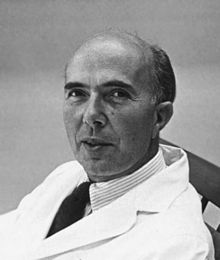Renato Dulbecco
Renato Dulbecco | |
|---|---|
 | |
| Born | February 22, 1914 Catanzaro, Italy |
| Died | February 19, 2012 (aged 97) |
| Nationality | Italian, American[3] |
| Alma mater | University of Turin |
| Known for | Reverse transcriptase |
| Awards |
|
| Scientific career | |
| Fields | Virologist |
| Institutions | |
| Doctoral students | Howard Temin[2] |
Renato Dulbecco (
Early life
Dulbecco was born in
Career and research
After the war he resumed his work at Levi's
Throughout this time he also worked with
Nobel Prize
Dulbecco and his group demonstrated that the infection of normal cells with certain types of viruses (oncoviruses) led to the incorporation of virus-derived genes into the host-cell genome, and that this event lead to the transformation (the acquisition of a tumor phenotype) of those cells. As demonstrated by Temin and Baltimore, who shared the Nobel Prize with Dulbecco, the transfer of viral genes to the cell is mediated by an enzyme called reverse transcriptase (or, more precisely, RNA-dependent DNA polymerase), which replicates the viral genome (in this case made of RNA) into DNA, which is later incorporated in the host genome.
Oncoviruses are the cause of some forms of human
Other awards
In 1965 he received the
References
- ^ a b "Fellowship of the Royal Society 1660-2015". London: Royal Society. Archived from the original on 2015-10-15.
- PMID 11615362.
- ^ Dulbecco is a naturalized American citizen. See Dulbécco, Renato in www.treccani.it
- ^ "Dulbecco". The American Heritage Dictionary of the English Language (5th ed.). HarperCollins. Retrieved 28 August 2019.
- ^ "Dulbecco". Collins English Dictionary. HarperCollins. Retrieved 28 August 2019.
- ^ Gellene, Denise (February 20, 2012). "Renato Dulbecco, 97, Dies; Won Prize for Cancer Study". New York Times. Retrieved March 29, 2014.
- ^ "The Nobel Prize in Physiology or Medicine 1975". Nobelprize.org. 12 Sep 2012
- PMID 22437605.
- PMC 3323998.
- S2CID 54316919.
- S2CID 36014355.
- S2CID 206541174.
- ^ a b Nobel autobiography of Dulbecco
- ^ Renato Dulbecco telling his story at Web of Stories
- PMID 16589172.
- PMID 13130792.
- S2CID 6390065.
- ^ Judson, Horace (2003-10-20). "No Nobel Prize for Whining". New York Times. Retrieved 2007-08-03.
- ^ "The Nobel Prize in Physiology or Medicine 1975".
- ^ "Dottorato, Enciclopedia Treeccani".
- PMID 3945817.
- S2CID 32655658.
- PMID 17566110.
- PMID 18957543.
- ^ "Renato Dulbecco". American Academy of Arts & Sciences. Retrieved 2022-03-16.
- ^ "Selman A. Waksman Award in Microbiology". National Academy of Sciences. Archived from the original on 12 January 2011. Retrieved 15 February 2011.
- ^ "APS Member History". search.amphilsoc.org. Retrieved 2022-03-16.
External links
- Renato Dulbecco on Nobelprize.org
